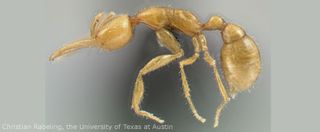Insects

Find out everything there is to know about insects and stay updated on the latest insect research with the comprehensive articles, interactive features and insect pictures at LiveScience.com. Learn more about these fascinating species as scientists continue to make amazing discoveries about insects.
Explore Insects
Latest about Insects

Watch ancient, giant millipede the size of a car brought back to life in remarkable reconstruction
By Hannah Osborne published
The massive, extinct millipede Arthropleura has been brought back to life in a stunning reconstruction for the Netflix series "Life on Our Planet."

Hercules beetle: The titan insect with giant horns for love and war
By Megan Shersby published
Hercules beetles can grow to almost 7 inches long and are among the largest flying insects on Earth.

Gum leaf skeletonizer: The venomous 'Mad Hatterpillar' that wears its old heads like a crown
By Megan Shersby published
Rather than throw its old head cases away, the gum leaf skeletonizer wears them like a hat to protect itself from predators.

Caterpillars evolved their weird chubby little 'prolegs' from ancient crustaceans
By Richard Pallardy published
The extra legs caterpillars have appear have origins in the primitive crustaceans that insects evolved from during the Ordovician period over 400 million years ago.

Soldier ants turned into foragers by scientists reprogramming their brains
By Sneha Khedkar published
Scientists discovered an enzyme within the ant "blood-brain barrier" that helps control whether an ant ends up a soldier or a forager.

Tortoise beetle larvae use their telescopic anuses to build shields from shed skin and poop
By Richard Pallardy published
Many tortoise beetle larvae create shields for themselves using faeces and old skin. Scientists have now looked at how and why they create these poop parasols.

3,000-year-old mummified bees are so well preserved, scientists can see the flowers the insects ate
By Ethan Freedman published
The bees were preserved well enough for researchers to make out small features, like their legs and antennae.

Invasive yellow-legged hornets spotted in US for 1st time, one nest eradicated
By Megan Shersby last updated
The invasive yellow-legged hornet, which preys on honey bees, has been spotted in Georgia for the first time.

Fuzzy caterpillar has sting 'like being hit with a baseball bat," and now we know why
By Sascha Pare published
Scientists have discovered proteins in the caterpillars' venom that fold up "like a little donut" to punch holes in the victim's cells, delivering extremely potent pain signals to the brain.

Ecologist Tim Blackburn: 'Moths pollinate a wider range of species than bees'
By Sascha Pare published
With colors ranging from candy pinks to golds and sometimes possessing wingspans as big as a bird's, moths are a fascinating group. Ecologist Tim Blackburn tells Live Science about the incredible, hidden world of moths.
Live Science newsletter
Stay up to date on the latest science news by signing up for our Essentials newsletter.
